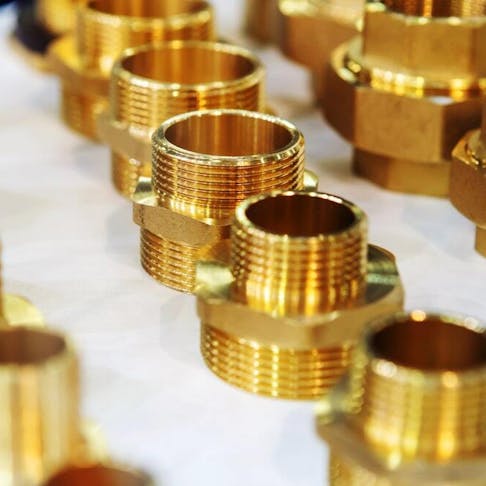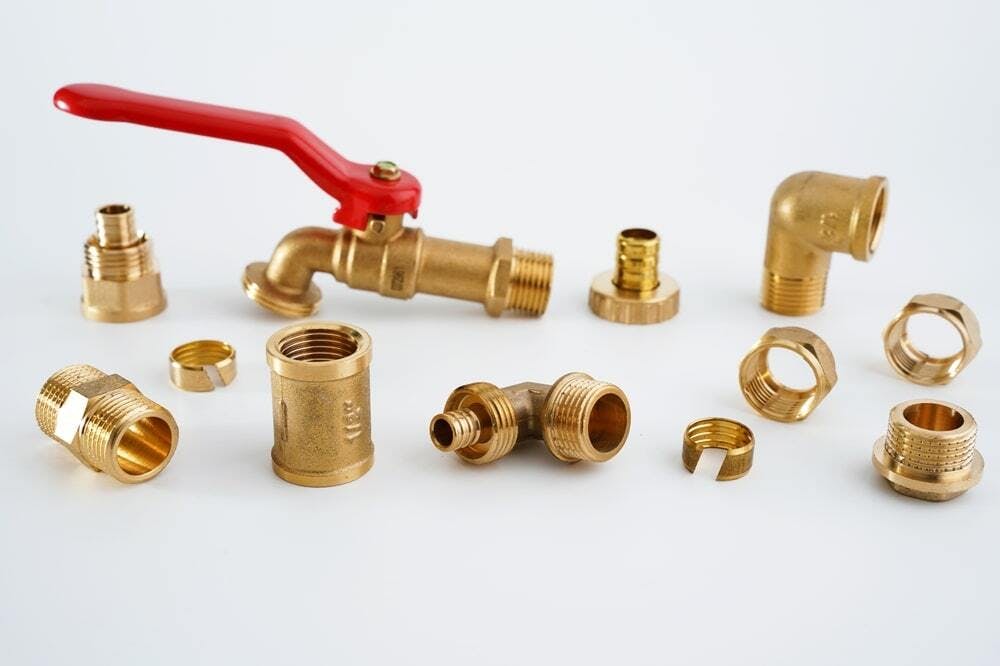
All About Brass as a Manufacturing Material
Learn more about this material, and its different properties and uses.

Brass is a metal alloy of copper and zinc containing trace amounts of lead, iron, and other elements. Brass has excellent resistance to seawater corrosion and is easy to machine and form. It also has a biocidal effect which makes it excellent for antibacterial applications.
This article will discuss what brass is and the various types of brass, as well as their mechanical and chemical properties. Figure 1 below shows some brass pipe fittings:
Brass faucet pipe fittings.
Image Credit: Shutterstock.com/MIKE MANIATIS
What is Brass?
Brass is a metal alloy of copper and zinc that typically has a golden-yellow color but can be closer to red if the alloy has high levels of copper (this is known as “red brass”). Brass is known for its excellent workability, machinability, and antibacterial and anti-biofouling characteristics.
What Are the Components of Brass?
Brass is an alloy of zinc and copper. The exact quantities of copper and zinc will determine the type of brass and its relevant properties. Additional alloying elements can be added to the blend to improve specific properties. For example, lead improves corrosion resistance and machinability, whereas iron increases the hardness and makes the alloy easier to forge.
What Are the Different Types of Brass?
There are many different brass alloys. However, they vary little in terms of elemental makeup. Listed below are some commonly used brass alloys:
- Alloy 260 (Cartridge Brass): This brass alloy contains approximately 70% copper and 30% zinc with impurities. This alloy has excellent hot formability and is readily cold-worked.
- Alloy 280 (Muntz Metal): This brass alloy contains approximately 60% copper and 40% zinc, as well as trace amounts of iron. A common application for Muntz metal was as a less expensive replacement for the copper sheeting formerly placed on boat hulls to prevent the growth of sea organisms such as barnacles on the hulls.
- Alloy C360 (Free Machining Brass): This brass alloy contains approximately 60% copper, 35.5% zinc, up to 3.7% lead, and trace quantities of iron. This alloy is one of the easiest materials of all the brasses to machine and is classified as having a 100% machinability rating. Typical applications include parts like gears or bushings.
- Alloy 385 (Architectural Bronze): Despite being called bronze, 385 brass is an alloy that contains approximately 59% copper, 42% zinc, and up to 3.5% lead. This dramatically improves its machinability and formability. Its ease of forming makes it popular as an architectural material used for aluminum extrusions.
- Alloy 464 (Naval Brass): This brass alloy contains approximately 59% copper, 40% percent zinc, and 1% tin, with a small amount of lead. The combination produces a metal with exceptional corrosion resistance. Applications can include the various fittings found on the deck of a boat.
What Are the Properties of Brass?
Table 1 below lists the mechanical and elemental makeup of the more common brass alloys:
| Alloy 260 | Alloy 280 | Alloy 360 | Alloy 385 | Alloy 464 | |
|---|---|---|---|---|---|
Alloy 260 Composition (wt %) | Alloy 280 Cu: 68.5 - 71.5 Zn: 28.5 - 31.5 Fe <= 0.05 Pb <= 0.070 | Alloy 360 Cu: 59 - 63 Zn: 40 Fe <= 0.070 Pb <= 0.3 | Alloy 385 Cu: 60-63 Zn: 35.5 Fe <= 0.35 Pb <= 2.5-3.7 | Alloy 464 Cu: 55 - 59 Zn: 36.65-41.65 Fe <= 0.35 Pb <= 2.5-3.5 | Cu: 55 - 59 Zn: 36.65 - 41.65 Zn Fe <= 0.35 Pb <= 2.5-3.5 |
Alloy 260 Density (g/cm3) | Alloy 280 8.53 | Alloy 360 8.39 | Alloy 385 8.49 | Alloy 464 8.47 | 8.41 |
Alloy 260 Hardness, Rockwell (F, B) | Alloy 280 54 F | Alloy 360 85 F | Alloy 385 78 B | Alloy 464 65 B | 55 B |
Alloy 260 Yield Strength (MPa) | Alloy 280 75 | Alloy 360 145 | Alloy 385 124-310 | Alloy 464 138 | 172-455 |
Alloy 260 Ultimate Tensile Strength (MPa) | Alloy 280 300 | Alloy 360 370 | Alloy 385 338-469 | Alloy 464 414 | 379-607 |
Alloy 260 Elongation @ Break (%) | Alloy 280 68 | Alloy 360 45 | Alloy 385 53 | Alloy 464 30 | 50 |
Alloy 260 Modulus of Elasticity (GPa) | Alloy 280 110 | Alloy 360 105 | Alloy 385 97 | Alloy 464 - | 100 |
Alloy 260 Machinability (%) | Alloy 280 30 | Alloy 360 40 | Alloy 385 100 | Alloy 464 90 | 30 |
Table Credit: https://matweb.com/
Where is Brass Made?
The European Union was the largest exporter of brass in 2021, with a total product value of 163 million USD. India and South Korea are the next largest exporters of brass.
What Are the Applications of Brass?
Brass has a wide range of applications due to its excellent workability, corrosion resistance, and antibacterial properties. Some of these applications are listed below:
- Bullet cartridges
- Pipes
- Musical instruments
- Door handles and hinges
- Gears
- Marine engines
- Tools
- Valves
- Pipe fittings
How Strong is Brass?
Certain grades of brass can be heat treated, which means that the strength of brass depends on the composition of the alloy and the type of heat treatment applied. For example, naval brass can be cold drawn and annealed to achieve an ultimate tensile strength of 580 MPa, which is comparable to some grades of steel. Heat-treated brass is often used for valve bodies due to the requirement of having to withstand high pressures.
What Are the Advantages of Brass?
Listed below are some common advantages of using brass:
- Easy to Machine: Brass is one of the easiest materials to machine, especially free-machining brass, which has a machinability rating of 100%.
- Low Friction: Brass has a low coefficient of friction. This makes it ideal for sliding-wear applications.
- Anti-bacterial: The copper content in brass kills certain types of bacteria. This property makes it ideal for use in applications like door knobs, to prevent the transfer of bacteria. Brass also prevents biofouling in marine applications.
What Are the Disadvantages of Brass?
Listed below are some common disadvantages of using brass:
- Prone to Tarnishing: Brass can form a blackish tarnish due to oxidation if not properly maintained. Brass may need to be coated with a clear lacquer to prevent this.
- Non-Hypoallergenic: Brass can cause skin irritation to people with sensitive skin due to copper or zinc content if not properly treated with a lacquer coating, for example.
- High Cost: Compared to other common metals like steel, brass is more expensive due to its high copper content. Copper is a very expensive material.
What is the Maximum Operating Temperature of Brass?
Table 2 below lists the solidus temperature (melting onset) and the liquidus temperature (melting completion) for some common grades of brass:
| Brass Grade | Solidus Melting Point (°C) | Liquidus Melting Point (°C) |
|---|---|---|
Brass Grade Alloy 260 | Solidus Melting Point (°C) 915 | Liquidus Melting Point (°C) 955 |
Brass Grade Alloy 280 | Solidus Melting Point (°C) 900 | Liquidus Melting Point (°C) 905 |
Brass Grade Alloy 360 | Solidus Melting Point (°C) 885 | Liquidus Melting Point (°C) 900 |
Brass Grade Alloy 385 | Solidus Melting Point (°C) 875 | Liquidus Melting Point (°C) 890 |
Brass Grade Alloy 464 | Solidus Melting Point (°C) 885 | Liquidus Melting Point (°C) 900 |
Table Credit: https://matweb.com/
Is Brass Safe to Use?
Yes, brass is safe to use for general engineering applications but is not recommended when coming into contact with acidic food (pH < 6). Brass is toxic to some microscopic organic life due to the negative effect of copper ions on various microscopic living organisms. Brass can also prompt an allergic reaction in persons with skin sensitivity.
What is the Difference Between Copper, Brass, and Bronze?
All three are commonly referred to as “red metals.” Brass and bronze both contain copper as their main element. Brass contains zinc as the main secondary element and bronze typically contains tin as its secondary element. Bronze is especially resistant to corrosion from seawater whereas brass has excellent low-friction capabilities. Copper, on the other hand, is well suited to electrical applications due to its high conductivity.
Summary
This article presented brass, explained what it is, and discussed how it's used and its different properties. To learn more about brass, contact a Xometry representative.
Xometry provides a wide range of manufacturing capabilities and other value-added services for all of your prototyping and production needs. Visit our website to learn more or to request a free, no-obligation quote.
Disclaimer
The content appearing on this webpage is for informational purposes only. Xometry makes no representation or warranty of any kind, be it expressed or implied, as to the accuracy, completeness, or validity of the information. Any performance parameters, geometric tolerances, specific design features, quality and types of materials, or processes should not be inferred to represent what will be delivered by third-party suppliers or manufacturers through Xometry’s network. Buyers seeking quotes for parts are responsible for defining the specific requirements for those parts. Please refer to our terms and conditions for more information.

